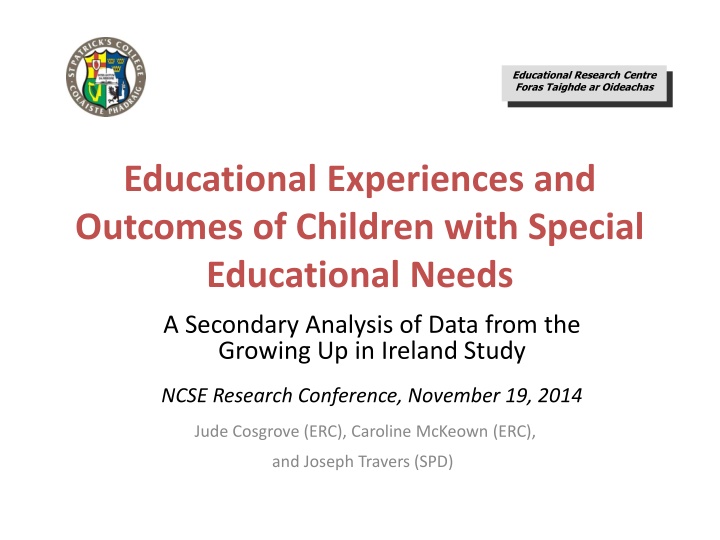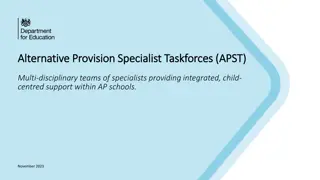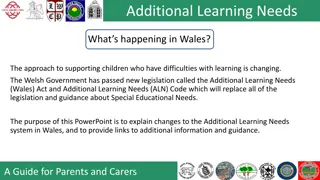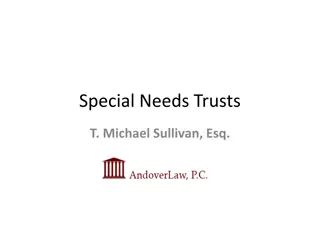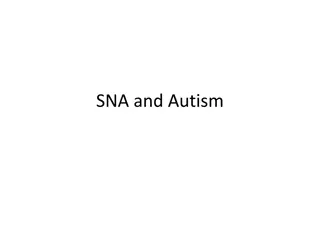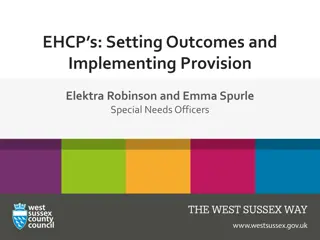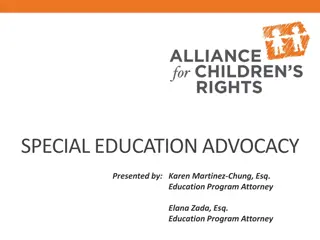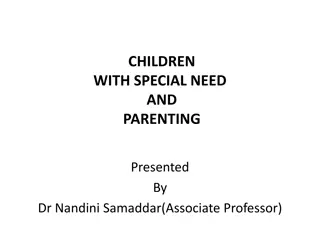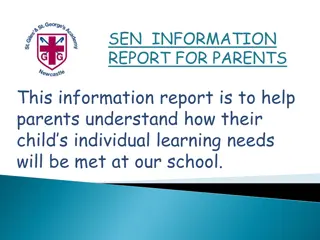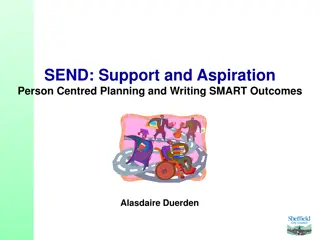Educational Outcomes of Children with Special Educational Needs
Despite limited evidence, a research study conducted by the Educational Research Centre and St. Patrick's College delved into the educational experiences and outcomes of children with special educational needs in Ireland. Utilizing data from the Growing Up in Ireland study, the research aimed to analyze academic attainment, participation, engagement, progress, independence, well-being, and relationships of these children. The report provides key findings and implications for educational policy and practice based on data from Wave 1 of the Child Cohort.
Download Presentation

Please find below an Image/Link to download the presentation.
The content on the website is provided AS IS for your information and personal use only. It may not be sold, licensed, or shared on other websites without obtaining consent from the author.If you encounter any issues during the download, it is possible that the publisher has removed the file from their server.
You are allowed to download the files provided on this website for personal or commercial use, subject to the condition that they are used lawfully. All files are the property of their respective owners.
The content on the website is provided AS IS for your information and personal use only. It may not be sold, licensed, or shared on other websites without obtaining consent from the author.
E N D
Presentation Transcript
Educational Research Centre Foras Taighde ar Oideachas Educational Experiences and Outcomes of Children with Special Educational Needs A Secondary Analysis of Data from the Growing Up in Ireland Study NCSE Research Conference, November 19, 2014 Jude Cosgrove (ERC), Caroline McKeown (ERC), and Joseph Travers (SPD)
Background Despite significant investments in supporting children with special educational needs, there has been limited evidence relating to the educational engagement, progress or outcomes of these children The National Council for Special Education issued a call for tender in January 2013 in order for empirical research in this area to be undertaken A team at the Educational Research Centre and St Patrick s College, Drumcondra, commenced work in February 2013, and submitted a report to the NCSE in September 2014 Jude Cosgrove, Caroline McKeown, Peter Archer (ERC) Joe Travers, Zita Lysaght, rla N Bhroin (SPD) This presentation provides some of the key findings and conclusions from the report
Background Using the Growing Up in Ireland 9-year-old cohort (2007), the aims were to: help us understand more clearly how children with special educational needs, and specific identifiable subgroups of these children, were faring at school in terms of outcomes which relate to academic attainment/achievement participation in and engagement with school and learning learning progress Independence wellbeing and relationships. identify and analyse the factors associated with children s outcomes and to identify potential implications for educational policy and/or practice. We have not examined progress in the present study.
Background A note on Growing Up in Ireland Large-scale longitudinal study of children (Office of the Minister for Children; part of the National Children s Strategy) Two age cohorts are included, with data from two survey administrations completed: Infant cohort nine months (Sept 2008-April 2009) and three years (Jan- Aug 2011) Child cohort nine years (Sept 2007-June 2008) and 13 years (Aug 2011- Mar 2012) The first data collection is called Wave 1 and the second is Wave 2 This report uses data from the Wave 1 Child Cohort Around 8,500 children, their parents, teachers and school principals took part in Wave 1 These individuals completed questionnaires; children also took reading and mathematics tests; and a subset of families took part in qualitative interviews
Overview of Presentation Classification scheme for special educational needs (SEN) used in the study Outcomes examined Limitations of the study A selection of key quantitative findings Children s outcomes Children s background characteristics Outcomes in context Key themes emerging from qualitative analyses Key recommendations The findings presented here are just a small selection from the full report
Classification scheme for SEN SEN was identified on the basis of teacher and parent responses Eight groups were identified initially children with: 1. a physical or sensory disability (no distinction between sub-types) 2. a social, emotional or behavioural disability or difficulty (SEBD), medium risk (not directly measured) 3. a social, emotional or behavioural disability or difficulty (SEBD), high risk (not directly measured) 4. a general learning disability or difficulty (GLD) (no distinctions between mild, moderate, severe/profound) 5. autistic spectrum disorders (ASD)(incl. Asperger s Syndrome) 6. speech and language difficulty (SLD) 7. dyslexia 8. other special educational needs not already covered in the above About 30% of children with special educational needs, or 8% of all children, have more than one special educational need
Final SEN classification scheme As a second step, we looked at combinations of special educational needs to come up with a 12-group classification that was used in the report Estimated prevalence is 27.8% - similar to Banks & McCoy (2011) 25% Without including medium risk SEBD, prevalence is 20.2% Category % of all children (N=8568) % of children with SEN (N=2381) N Medium risk SEBD only High risk SEBD only GLD GLD with medium or high risk SEBD Dyslexia (including 15 cases with another specific SEN) Dyslexia with medium or high risk SEBD Speech and Language disorder (including 24 cases with another specific SEN) Speech and language disorder with medium or high risk SEBD Autistic spectrum disorder or Asperger s syndrome (66 of these also having another SEN or SENs) Physical or sensory disability only Physical or sensory disability with medium or high risk SEBD and/or other general or specific SEN(s) Other special educational need(s) No special educational need(s) 619 371 246 125 187 100 101 7.2% 4.3% 2.9% 1.5% 2.2% 1.2% 1.2% 26.0% 15.6% 10.3% 5.2% 7.9% 4.2% 4.2% 91 1.1% 3.8% 69 0.8% 2.9% 68 158 0.8% 1.8% 2.9% 6.6% 246 6187 2.9% 72.2% 10.3% ---
Final SEN classification scheme by gender Overall, SEN is more prevalent in males, though varies a lot across groups. SEN group Female Male No special educational need(s) 51.8% 48.2% Any special educational need(s) 41.3% 58.7% Of those with any special educational needs . Compare, for example: Medium and high risk SEBD Medium risk SEBD only 48.0% 52.0% High risk SEBD only 33.0% 67.0% GLD (including some cases with another SEN) 53.6% 46.4% GLD with medium or high risk SEBD 47.4% 52.6% Dyslexia with and without SEBD Dyslexia (including some cases with another SEN) 50.3% 49.7% Dyslexia with medium or high risk SEBD 41.7% 58.3% Speech and Language disorder (including some cases with another SEN) 34.0% 66.0% Speech and language disorder with medium or high risk SEBD 41.7% 58.3% Physical or sensory disabilities with and without SEBD Autistic spectrum disorder or Asperger s Syndrome 17.5% 82.5% Physical or sensory disability only 44.7% 55.3% Physical or sensory disability with medium or high risk SEBD and/or other SEN(s) 53.9% 46.1% Other special educational need(s) 48.0% 52.0% All children 51.4% 48.6%
Limitations of the study 1. There is no examination of progress over time (yet) 2. Questions about SEN and hence the classification scheme is problematic in some respects (e.g., GLD and SEBD) 3. Very little information on supports for SEN was collected 4. The sample design is not well suited to examining school and class characteristics in terms of how they relate to children s outcomes 5. There is no direct, one-to-one link between the quantitative and qualitativedatasets (originally planned, but not feasible to implement) 6. The numbers of children in some of the SEN groups examined here are too small to allow us to comment on specific SENs to the extent that we might have liked
Outcomes examined Following Douglas et al. (2012): Progress over time will be examined using Wave 2 of GUI
Drumcondra Reading and Maths scores, by SEN group (M=100, SD=15) 110 105 100 95 90 85 80 Reading Mathematics Overall, children with SEN score two-thirds of a standard deviation lower on both reading and maths than children without SEN. However there is a lot of variation across the 12 groups. Children with physical and sensory disabilities have mean reading and maths scores that are not significantly different to the no-SEN group.
Distribution of Drumcondra Reading scores, by SEN group 35% 30% 25% 20% 15% 10% 5% 0% 77.4 or less (more than 1.5 SD below mean) 122.6 or higher (more than 1.5 SD above mean) A significant minority of children with medium and high risk SEBD, ASD and physical and sensory disabilities have high scores (>1.5 SD above mean). Variation in scores of ASD and high risk SEBD groups is particularly high. More info on maths is in the full report.
Teachers ratings of pupils reading and maths proficiency Six times as many children with SEN were rated below average on reading, and five times as many below average on maths, compared to children without SEN. Children without SEN were 2.5 times more likely to be rated above average on both subjects than children with SEN. Below average Average Above average Reading No SEN: 7.3% 45.9% 46.8% SEN: 42.6% 39.4% 18.0% Mathematics No SEN: 8.1% 52.7% 39.2% SEN: 37.6% 47.2% 15.2%
Comparison of teachers rating with children s test scores Some differences between children with and without SEN might be expected, but when we compared teachers ratings with children s test scores we find: Underestimated by teacher Overestimated by teacher Reading No SEN: 3.6% 21.3% SEN: 7.5% 11.6% Mathematics No SEN: 5.2% 18.1% SEN: 7.5% 11.6% For reading, twice as many children with SEN than without SEN were underestimated by teachers, and twice as many children without SEN than with SEN were overestimated by their teachers. Neither source of info is invalid. Local (class) norms?
Parental educational expectations for child, by SEN group 100% 80% 60% 40% 20% 0% Up to LC App, Cert. or Dip Degree or PG Degree Degree or PG Degree SEN group Up to LC App, Cert. or Dip No special educational need(s) 7.8% 14.7% 77.6% Any special educational need(s) 20.8% 25.8% 53.4%
Childrens low liking of school and school subjects, by SEN group All children No SEN Any SEN MED SEBD HI SEBD GLD GLD & SEBD DYS DYS & SEBD SLD SLD & SEBD ASD PHYS PHYS & OTH OTHER 0% 5% 10% 15% 20% 25% 30% Low liking of school is based on a three-level categorisation that took children s liking of school, reading, and maths into account.
Childrens scores on a measure of wellbeing (Piers-Harris), by SEN group (M=50, SD=10) Category All children No SEN Any SEN Mean SD 50.0 51.4 46.1 10.0 9.3 10.9 SEN-No SEN difference is half a standard deviation MED SEBD HI SEBD GLD GLD & SEBD DYS DYS & SEBD SLD SLD & SEBD ASD PHYS PHYS & OTH OTHER 10.6 12.8 10.2 11.3 9.5 10.9 10.0 9.5 9.0 7.9 10.0 10.9 47.4 44.6 47.4 43.1 47.8 42.8 48.7 42.6 45.6 52.3 47.6 43.1 Pattern illustrates the additive impact of SEBD Figures in bold = statistically significantly different from the no-SEN group mean (p < .01) Figures in green = very low scores. Report also examines the P-H subscales.
Socio-economic index (SEI) and percentage of household income from social welfare payments (%SW), by SEN group 60 50 40 30 20 10 0 SEI (M=50, SD=10) % SW SEI has M=50 and SD=10, based on conversion of ISCO codes to ISEI codes. Children with high risk SEBD and SLD with SEBD have both high % SW and low SEI scores. More variation in %SW than SEI across SEN groups.
Distribution of SEN groups across level of parental education No special educational need(s) Any special educational need(s) SEN group Parents of children with SEN are twice as likely to have up to lower secondary education (33.9% v 17.3%) Up to lower sec 17.3% 33.9% Upper sec, tech or voc 34.5% 30.9% 3rd level, non degree Parents of children without SEN are twice as likely to have a post-grad qualification (12.6% v 6.6%) 19.9% 16.9% 3rd level prim degree 15.7% 11.6% 3rd level post-grad 12.6% 6.6%
Distribution of SEN groups across levels of basic care 100% 90% 80% 70% 60% 50% 40% 30% 20% 10% 0% No signs of lack of basic care Basic care is based on teachers responses relating to the frequency with which the child arrives to school tired, inadequately dressed for the weather, without lunch, hungry, and with a lack of cleanliness. Lack of basic care exceeds 12% among children with high risk SEBD, GLD and SEBD, dyslexia and SEBD, SLD and SEBD, and ASD. Across all children, it is only 3%. Few signs of lack of basic care Signs of lack of basic care
Percentages of SEN groups with three or more adverse events experienced 25% 20% 15% 10% 5% 0% Adverse life events: death of parent; death of close family member; death of close friend; divorce/separation of parents; staying in foster home/residential care; serious illness/injury; drug taking/alcoholism in immediate family; mental disorder in immediate family; conflict between parents; parent in prison; other disturbing event. Multiple adverse life events are twice as high among children with SEN relative to children without SEN. There is considerable variation across SEN groups.
Childrens outcomes in context So far, we have seen wide variations in children s outcomes and background characteristics. This part of the analysis looks at outcomes in the context of variations in background characteristics Are the observed differences occurring independently of children s backgrounds? What might the results suggest about policy interventions? Global? Targeted?
Childrens outcomes in context Multiple linear regression modelling compared differences across children in the 12 SEN groups with children without SEN on nine outcomes, before and after accounting for demographic, socioeconomic, school, class and community characteristics. These were: 1. Reading achievement 2. Mathematics achievement 3. Parental educational expectations 4. Liking of school and school subjects 5. Number of days absent over the past school year 6. Experiencing bullying 7. Piers-Harris freedom from anxiety subscale scores 8. Piers-Harris happiness subscale scores 9. Level of participation in daily self-care activities. We discuss just two of these models for illustrative purposes.
Childrens outcomes in context: Reading scores 1. Reading scores of children with a physical or sensory disability did not differ from the scores of children without SEN in any of the models: children with a physical or sensory disability are doing just as well as children without SEN, regardless of home, school and community characteristics. 2. Reading scores of children with high risk SEBD did not differ significantly from those of children without SEN once account was taken of their demographic, socioeconomic and home background characteristics: supports that take children s broader contexts into account may be appropriate for these children. 3. The mean reading score of children with ASD was the same as children without SEN before accounting for background characteristics, yet was significantly lower than would be expected once account was taken of their background characteristics, and in particular, school characteristics: school environments of these children may not be optimal for their academic performance.
Childrens outcomes in context: Parental educational expectations After accounting for home, school, and community characteristics, all SEN groups (except children with physical or sensory disabilities) were significantly less likely to have parents expecting them to obtain a third level degree. 1. 2. Children with the lowest adjusted parental educational expectations were those with GLD and SEBD, dyslexia and SEBD, and ASD. 3. Low parental educational expectations is an issue of general concern, and potentially suited to a global policy intervention that is aimed at informing parents and children about the full range of educational opportunities, and increasing parental educational expectations for all children with SEN.
Qualitative themes and sub-themes Based on analyses of child and parent interviews and field notes of 31 children and their families with confirmed SEN, likely SEN, and/or a sibling with SEN We identified three overlapping overarching themes, each with sub-themes School and educational context Child wellbeing Home environment Focus here is on school and educational context for illustrative purposes
School and Educational Context Key findings Some dislike of school, tests or certain school subjects Parental awareness of child strengths and weakness; a holistic perspective Some evidence that the structured school system did not suit some children Some evidence that children s non-academic strengths and interests were being overlooked within the education system
Extract from Child Interview Despite some difficulties described by one girl s parents, she seemed to enjoy going to school but disliked some subjects because she found them hard: I: Do you enjoy school? C: Yeah because you get to see your friends every day and you don t get to see them every day in the summer and then I don t like school because of work. I: What do you not like? C: Maths and Irish but I like the rest. I: Why? C: I don t like Maths because I just don t like maths and it is hard and you get a test on them. I: And what about Irish? C: It is really hard and it is not fun at all. Note. This triangulates with our quantitative findings on low liking of maths and particularly Irish among children with SEN.
Extract from Parent Interview One mother described her son s talent for drawing, expressing frustration that this skill and talent was not being nurtured in the education system: M: he used to draw as a child before he went to school amazing drawings and of course school destroys it and then as soon as he was in school, like after six months, he stopped doing these drawings he is clearly an engineer or something like that. So em and it kind of irritates me because the education system doesn t encourage that and whereas he is doing quite mediocre to average in school you know he has got a brightness and a smartness that isn t being developed in the school system. Note. This may put some of our findings regarding differential levels of engagement into context.
Extract from Parent Interview The parents of one girl with dyslexia spoke of the difference in her engagement with her schoolwork and in her increased confidence due to the support she had received: M: She gets help with maths, English and reading and she gets extra homework as well She is flying through it now. F: There is some difference since she got the extra help. It has made some difference for her reading especially. M: Her confidence. F: Her confidence as well. M: Before she wouldn t even. F: Chance something. She was so hesitant to make a stab at a word because of the dyslexia. I: And does she like school now? M: She likes it more. We keep saying it doesn t matter if you get it wrong we say just try it.
Annotated: Not all recommendations are included here See conference pack for full set of recommendations Recommendations (1) Assessment and Progress Assessment tools for children with special educational needs should be developed for use in primary school settings in Ireland. The tools should be easy for teachers to use, suitable for monitoring progress, and be accompanied by guidelines for using results. A programme of professional development should be implemented to support the use of any assessment tools for children with special educational needs.
Recommendations (2) Social, Emotional and Behavioural Difficulties An instrument for use by teachers in order to identify SEBD should be developed. The instrument should be capable of distinguishing between moderate and more severe forms of SEBD, as well as internalising and externalising forms. Any possibly identification of SEBD by teaching staff needs to be accompanied by appropriate allocations of resources and supports and strategies for fostering effective communication with parents.
Recommendations (3) Clustering of children with SEN It is recommended that the extent to which children with SENs are clustered in particular schools be examined further, in order to determine how a critical mass of children with SEN in a school may be appropriately supported through the allocation of additional resources at the level of the school. Issue is currently under examination by NCSE
Recommendations (4) Engagement and parental expectations Simple and practical information on future education and training opportunities should be disseminated among parents, teachers, and schools, specifically targeted at adolescents and young adults with special educational needs. Efforts need to be increased to engage children with SEN by building capacity in schools to address the needs of the diverse cohort of children with SEN, within an inclusive education framework.
Recommendations (5) Variations in strengths and needs It is recommended that the characteristics and needs of certain sub-groups be examined further in follow-up research, specifically Those of children with SEBD; in particular, with respect to their wellbeing and home environments; Children with multiple special educational needs; Children with ASD; in particular, their assignment to specific classrooms and schools.
Recommendations (6) Children s experiences of being bullied We recommend that teachers and school management engage in professional development in the area of bullying as part of an holistic approach to behaviour management. We recommend the provision of support courses for parents that provide guidelines on identifying behaviours that may be symptomatic of bullying, and ways to talk to their child about these. We recommend that Wave II data be used to research bullying further.
Recommendations (7) Home and family environment Early identification of SEBD needs to be prioritised within an overall framework of supports for special educational needs that takes community, family, school and individual children s characteristics into account. Further research is needed to identify and measure those characteristics for groups of children who may be most at risk of developing special educational needs, particularly those involving SEBD, at an early stage of their development.
Thank you! Thanks also to our colleagues in the ERC and SPD Special Ed Department, the GUI research team, and to Clare Farrell and Jennifer Doran in the NCSE
